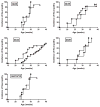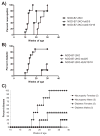Distinct genetic control of autoimmune neuropathy and diabetes in the non-obese diabetic background
- PMID: 23850635
- PMCID: PMC4156399
- DOI: 10.1016/j.jaut.2013.06.005
Distinct genetic control of autoimmune neuropathy and diabetes in the non-obese diabetic background
Abstract
The non-obese diabetic (NOD) mouse is susceptible to the development of autoimmune diabetes but also multiple other autoimmune diseases. Over twenty susceptibility loci linked to diabetes have been identified in NOD mice and progress has been made in the definition of candidate genes at many of these loci (termed Idd for insulin-dependent diabetes). The susceptibility to multiple autoimmune diseases in the NOD background is a unique opportunity to examine susceptibility genes that confer a general propensity for autoimmunity versus susceptibility genes that control individual autoimmune diseases. We previously showed that NOD mice deficient for the costimulatory molecule B7-2 (NOD-B7-2KO mice) were protected from diabetes but spontaneously developed an autoimmune peripheral neuropathy. Here, we took advantage of multiple NOD mouse strains congenic for Idd loci to test the role of these Idd loci the development of neuropathy and determine if B6 alleles at Idd loci that are protective for diabetes will also be for neuropathy. Thus, we generated NOD-B7-2KO strains congenic at Idd loci and examined the development of neuritis and clinical neuropathy. We found that the NOD-H-2(g7) MHC region is necessary for development of neuropathy in NOD-B7-2KO mice. In contrast, other Idd loci that significantly protect from diabetes did not affect neuropathy when considered individually. However, we found potent genetic interactions of some Idd loci that provided almost complete protection from neuritis and clinical neuropathy. In addition, defective immunoregulation by Tregs could supersede protection by some, but not other, Idd loci in a tissue-specific manner in a model where neuropathy and diabetes occurred concomitantly. Thus, our study helps identify Idd loci that control tissue-specific disease or confer general susceptibility to autoimmunity, and brings insight to the Treg-dependence of autoimmune processes influenced by given Idd region in the NOD background.
Keywords: Autoimmunity; Diabetes; Idd loci; NOD-B7-2KO mice; Peripheral neuropathy; Tregs.
Copyright © 2013 The Authors. Published by Elsevier Ltd.. All rights reserved.
Figures





References
-
- Anderson MS, Bluestone JA. The nod mouse: a model of immune dysregulation. Annu Rev Immunol. 2005;23:447–85. - PubMed
-
- Hu Y, Nakagawa Y, Purushotham KR, Humphreys-Beher MG. Functional changes in salivary glands of autoimmune disease-prone NOD mice. Am J Physiol. 1992;263:E607–14. - PubMed
-
- Many MC, Maniratunga S, Denef JF. The non-obese diabetic (NOD) mouse: an animal model for autoimmune thyroiditis. Exp Clin Endocrinol Diabetes. 1996;104(Suppl 3):17–20. - PubMed
-
- Rivero VE, Cailleau C, Depiante-Depaoli M, Riera CM, Carnaud C. Non-obese diabetic (NOD) mice are genetically susceptible to experimental autoimmune prostatitis (EAP) J Autoimmun. 1998;11:603–10. - PubMed
MeSH terms
Substances
Grants and funding
LinkOut - more resources
Full Text Sources
Other Literature Sources
Medical
Molecular Biology Databases
Research Materials

